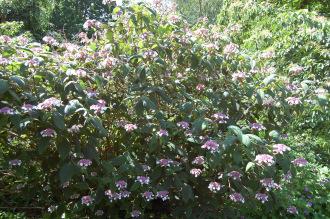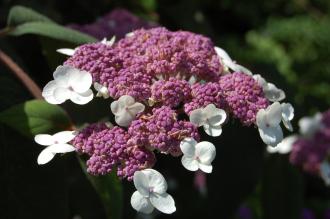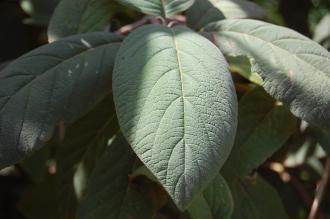
Hydrangea aspera ‘macrophylla’ (18/07/2015, Kew Gardens, London)
Position: Full sun to light shade
Flowering period: Summer to early autumn
Soil: Moist, well drained
Eventual Height: 2.5m
Eventual Spread: 2.5m
Hardiness: 7a, 7b, 8a, 8b, 9a, 9b
Family: Hydrangeaceae
Hydrangea aspera ‘macrophylla’ is a deciduous shrub with a bushy, lax habit . Its dark green leaves have a hairy upper surface, are lanceolate with entire margins, up to 28cm long and 14cm broad. Its hermaphrodite white to pale pink flowers appear in corymbs which are up to 25cm across.

Hydrangea aspera ‘macrophylla’ Flower (18/07/2015, Kew Gardens, London)
Hydrangea aspera, commonly known as the Rough Leaved Hydrangea, is native to southern China. In its native habitat it grows on mountain slopes in forests and thickets. The variety Hydrangea aspera ‘macrophylla’ is commonly know as Large Leaved Scabrous Hydrangea.
The etymological root of the binomial name Hydrangea is derived from the Greek hydor meaning ‘water’ and aggos meaning ‘jar’ which refers to the plants cusp shaped fruit. Aspera is from the Latin meaning ‘jagged’, in reference to the surface texture of the leaf. Macrophylla is derived from the Latin macro meaning ‘large’ and phyllus meaning ‘leaf’.

Hydrangea aspera ‘macrophylla’ Leaf (18/07/2015, Kew Gardens, London)
The landscape architect may find Hydrangea aspera ‘macrophylla’ useful for woodland edge plant, and will tolerate the dryer conditions within the root spread of trees.
Ecologically, Hydrangea aspera ‘macrophylla’ is of little value to UK wildlife.
The Royal Horticultural Society has given Hydrangea aspera ‘macrophylla’ their prestigious Award of Garden Merit in 1993.
Hydrangea aspera ‘macrophylla’ prefers moist, humus rich, well-drained soils. It tolerates most pH of soil.
Hydrangea aspera ‘macrophylla’ requires little maintenance.

Landscape Architecture

